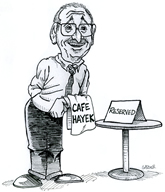Reviewing Richard Parker’s biography of John Kenneth Galbraith, Robert Skidelsky says the following about the price controls that Galbraith was instrumental in implementing during World War II:
Price controls were a success, the consumer price index barely budging in the war years [p. 147].
(Skidelsky’s review appears in the March 2006 issue of the Journal of Economic Literature.)
Skidelsky is correct only if one defines inflation as a change in the price level, and only if one measures the effectiveness of price controls by how well they prevent the price level from changing.
I hold no special affection for returning to (what I believe to have been) the older definition of inflation as being an increase in the money supply. Despite seeing a great deal of merit in this older definition, I wouldn’t go to the mat in opposition to defining inflation as an increase in the price level. But there is a problem with this way of defining inflation — namely, it allows people to suppose that price controls really control inflation.
Inflation might better be defined as a loss of purchasing power of the currency unit, "usually expressed as a general rise in the prices of goods and services" (see here).
Clearly, price controls do not prevent the value of the currency unit from falling. Yet when someone reads such a statement as the one quoted above from Skidelsky, one might carelessly conclude that price controls are indeed a useful tool for controlling inflation.



